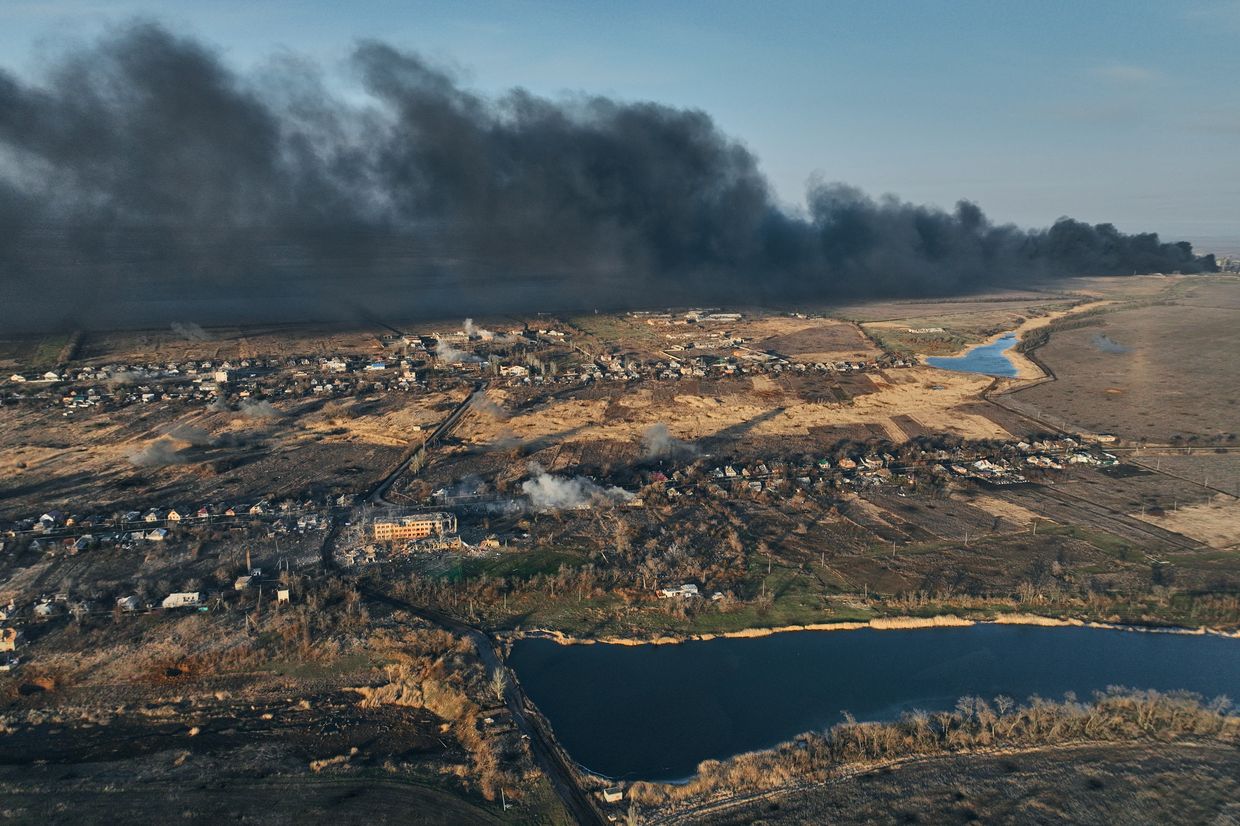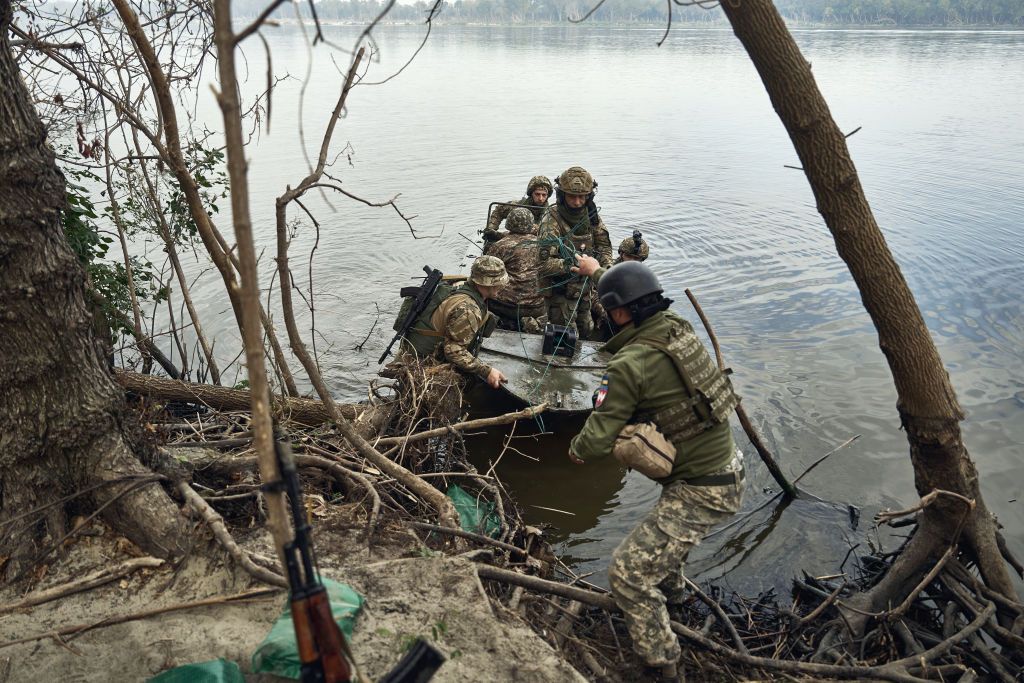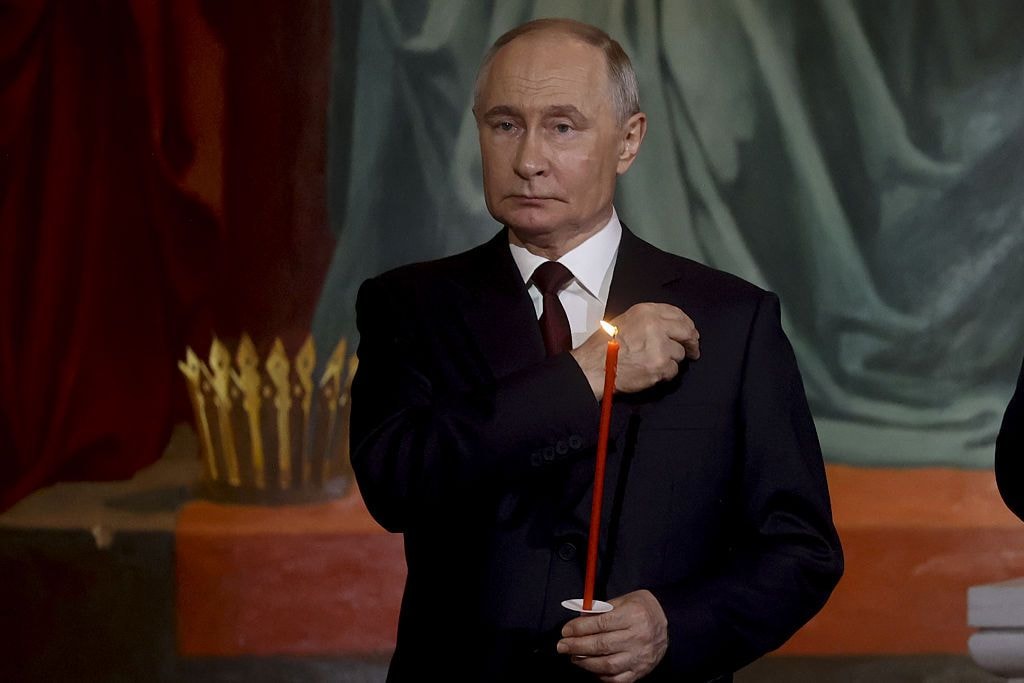
Ukrainian soldiers recall retreat from Avdiivka – on foot, leaving their wounded behind
Many Ukrainian soldiers have had to flee on foot from Avdiivka under heavy Russian shelling. (Illustration: Karolina Gulshani)
Editor’s Note: The Kyiv Independent does not disclose the soldiers’ full names since they were not authorized to speak with the press.
DONETSK OBLAST – As Russian forces closed in on a Ukrainian pocket southeast of Avdiivka, infantryman Oleh heard the order clearly: “There will be no evacuation. Leave 300 (the wounded).”
Oleh was among the last to flee the nearly encircled Zenit, a key position that has held off the Russian advance toward Avdiivka from the south since 2014.
In a bunker at the Zenit, a former air defense base, Oleh and his older comrade, Vasyl, said their goodbyes to the wounded. Of the six lying on the floor, Oleh was particularly close with Ivan, who he described as a young, sincere man who was hoping to see his family soon.
The clock was ticking. It was 6 a.m., Feb. 15, and Russians were drawing closer. After what felt like a half-an-hour conversation, Oleh and Vasyl left the bunker in a small group.
It was impossible to carry the wounded through a 2.5-kilometer journey to Avdiivka, a small industrial city on the verge of falling. Oleh’s own survival was also uncertain, as the Russians only left a 120-meter gap in their encirclement that Ukrainian soldiers could use to flee.
Brushing away emotions and focusing on survival, Oleh, a young man from Kharkiv Oblast, began to make his way toward the city, nearly surrounded by Russian forces.
“We were just left there (by our leadership),” Oleh told the Kyiv Independent a few days later, in a Donetsk Oblast town further from the front line. “We defended (the Zenit strongpoint) until the end.”

On Feb. 17, Ukraine’s new Commander-in-Chief Oleksandr Syrskyi announced Ukraine’s withdrawal from Avdiivka, a city once home to about 35,000 people located just outside Russian-occupied Donetsk.
Ukrainian troops have defended Avdiivka, a strategic hub that hosts the huge Soviet-era Avdiivka Coke Plant, since 2014, even after a brief Russian occupation. Russia intensified its offensive on Avdiivka twice in 2023, with the second one that began in October leading to the city’s fall.
Though outnumbered and outgunned, the Ukrainians fiercely held on to Avdiivka against what many soldiers described as the largest-ever frontal assault with columns of armored vehicles they’ve seen from Russia thus far.
Using the familiar tactics they applied during the Battle for Bakhmut, another Donetsk Oblast city that fell to Moscow in May 2023, the Russians ground forward on Avdiivka’s outskirts despite the heavy losses to slowly encircle Ukrainian troops inside.
The withdrawal from Avdiivka was late and disorganized, forcing many soldiers to make their escape by foot, under heavy shelling, four servicemen with Ukraine’s 110th Separate Mechanized Brigade, a large unit that manned the defense of Avdiivka and its outskirts, told the Kyiv Independent.
While agreeing that the Avdiivka defense was effective in grinding down Russia’s offensive capability that could be used elsewhere, Western military experts also criticized Ukraine for carrying out the retreat too late. Military analysts pointed out that Ukraine has made similar costly mistakes in Bakhmut, Soledar, and Sievierodonetsk.

Impossible escape
The two months of 2024 were extremely difficult for the soldiers defending Zenit, Oleh said.
Russian forces drew closer to the key supply route into Avdiivka by encircling the city from three sides, ramping up their attacks on the passing vehicles to reinforce troops inside.
Oleh said that by January, the remaining troops began rationing their bullets for rifles and machine guns, as well as food and water intake.
“A 1.5-liter bottle of drinking water was (what we had) for three people, for four days at least,” Oleh said, recalling the dire survival conditions.
The positions across Zenit have suffered heavily due to Russia’s constant use of guided air bombs, cluster munitions, and other weapons.
By February, Russian forces intensified their offensive around Avdiivka to complete its takeover.
At around 9 p.m. on Feb. 13, the remaining soldiers at Zenit received the order to flee toward Avdiivka “on their own,” according to Oleh.
Some of them began to flee in small groups, while the rest, including Oleh, stayed to hold the defense. While fighting off the Russian assaults to allow the other guys to escape, Oleh heard his friends getting wounded or killed on their way to Avdiivka one after another on the radio.
“We covered for ours, held the defense, while ours were trying to retreat, but they were bombarded with artillery – it was unbelievable,” Oleh said.
His brothers-in-arms evacuated six guys who were wounded not far from Zenit to a bunker, Oleh said. Oleh had hoped that by risking his life to keep covering for the rest of the guys, there was still some hope for an evacuation to arrive for the wounded in the bunker.
Those hopes were quickly shattered by the reality of the war.
Early on Feb. 15, Oleh heard his commander telling his comrades at the bunker that no vehicles or equipment could get there.
“They (the six wounded) waited until the 15th, thinking they would be taken away (by evacuation),” Oleh said. “On the 15th, they were told there would be no evacuation.”
Russian forces had breached the key road to Avdiivka by then, thwarting evacuation attempts and striking anything that passed with tanks and artillery, Anton Kotsukon, a spokesperson of the 110th brigade, said.
Getting to Avdiivka via the main road became impossible even before the withdrawal from the city, according to Kotsukon.

Making it out alive
Just as he stepped away from the bunker at Zenit, Oleh said he saw the first body of a comrade killed while fleeing. And then more and more.
Unable to help the wounded or collect the bodies of the killed, Oleh walked through the area heavily struck by Russian artillery, tanks, rockets, air bombs, and drones.
“We did not collect (the bodies) because we want to live too,” Oleh said. He said he was unable to count the bodies he saw on the path to Avdiivka.
In the case of shelling, Oleh dived into holes left behind after previous Russian shelling.
Carefully walking toward Avdiivka, Oleh said that his command stopped answering him at this point, and that they were completely “on their own.”
Five hours later, Oleh and his surviving comrades finally got to Avdiivka – from where they also had to flee near encirclement on foot toward the villages of Sievierne and Tonenke to the west.
The 110th’s spokesman, Kotsukon, said that the soldiers fleeing Zenit were assisted by drones from above to get to Avdiivka and then to an evacuation point, as long as they had a connection. He stressed that “everything possible and impossible” was done to evacuate the soldiers from Zenit.
Oleh and Vasyl said that no more than 40% of their company made it out alive, though declining to disclose the number of original troops before the encirclement. At the current stage in the war in Ukraine, infantry companies typically consist of 60-80 people.
Kotsukon didn’t provide the number of soldiers who were able to escape Zenit, but said that the losses were “minimal” even though large-scale withdrawals are “very difficult” operations.
“A certain number” of Ukrainian soldiers were captured while withdrawing from Avdiivka, but the number is not in the "hundreds," and it fluctuates as some first thought to be missing were able to flee the city, according to Dmytro Lykhovii, a spokesperson of the Tavriia Operational Strategic Group in charge of the southeastern front line.
Despite miraculously escaping Avdiivka, shocking news awaited the survivors from Zenit strongpoint. A Russian propaganda video showing several dead bodies of their friends emerged online.
A few days later, the 110th Separate Mechanized Brigade confirmed in a statement that “several” severely wounded and fallen soldiers could not be evacuated from Zenit. It said that the survivors were given an order to save their own lives, as evacuation routes were under heavy fire.
The 110th said that due to Zenit’s “complete encirclement,” it reached out to a government body in charge of prisoners of war (POWs) to strike an agreement with Russia to evacuate the wounded in exchange for their own – a deal, according to the brigade, agreed by Russia.
“We learned what happened next from enemy sources,” the statement reads, referring to the video.
The unit said that the three dead servicemen seen on the video were identified by their relatives. They include Ivan, Oleh’s friend. Another two servicemen left in the bunker were also killed, according to the 110th’s information. The fate of the last serviceman is uncertain, it added.
While the killing of POWs constitutes a war crime under the Geneva Convention, Russian forces have broken international law multiple times across the front line.
Remembering his final conversation with the six soldiers left behind at Zenit, Oleh said they wanted him to make it out alive to tell the story of what happened to them.
Reflecting on how they were abandoned, Oleh and Vasyl said they felt as though their lives didn’t matter to their leadership.
“We were told (on the radio), ‘get there (to an evacuation point) on your own’,” Oleh said. “There is no evacuation (in Avdiivka). There, you are on your own – you either die or you make it out.”
______________________________________________________
Note from the author:
Hi, this is Asami Terajima, the author of this article. Thank you for reading our story.
Hearing Oleh and his comrade Vasyl’s account of withdrawal from Avdiivka gave me shivers. I’ve been in Donbas for over two weeks at this point, and the atmosphere is different from how I remembered it last Fall – depressing and uncertain of the future. So many soldiers have lost their comrades in Avdiivka, and seeing another city fall like Bakhmut has been extremely hard for them.
To help the Kyiv Independent tell more stories that would otherwise not be told, please consider supporting us by becoming our patron.

















